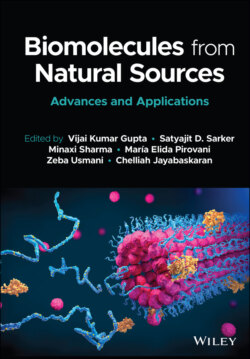Читать книгу Biomolecules from Natural Sources - Группа авторов - Страница 9
Preface
ОглавлениеDeveloping strategies for the use of natural resources and turning them into useful biomolecules and products at an economical cost is the need of the hour. Biomolecules have huge commercial and industrial applications due to their wide bioactive potential and biological activities. In regard to this, biomolecules obtained from natural resources, having biological activity can be used in the development of novel products and applications. Biomolecules have unique properties such as biodegradability, non-toxicity, biocompatibility, bioavailability, they are eco-friendly, and have diverse applications. These compounds can be defined as secondary metabolites and are produced as the primary biosynthetic pathway and metabolic routes of chief biological compounds associated with growth and development. Biomolecules can be extracted from several organisms ranging from cyanobacteria, bacteria, fungi, algae, viruses, plants, corals, and fish. In nature, biomolecular interactions are mostly associated with biochemical and biological diversity, especially in light of the discovery of associated biomolecules from various bioresources. These biologically active molecules derived from nature have novel applications which contribute to the wide range of natural product-based preparations and formulations currently being developed on an industrial/pilot scale. The understanding of the bioprocessing and applications of these biomolecules will help its value addition in the sectors of agriculture, food, biopharma, nutraceuticals, cosmeceuticals, therapeutic, and the environment. Thus, this book deals with the recent breakthrough in the technological progress and applications of naturally derived biomolecules. It provides students and researchers with important information about the natural sources of biomolecules, strategies of production, their pharmacological and health promoting properties, their advance use in drug therapy, and other possible future applications. This book also throws light on emerging techniques for studying naturally bioactive molecules.
Chapters from some renowned scientists working in this area provide recent and valuable information in the fields of screening, valorization, characterization, and new applications of natural biomolecules. Biological activities of natural glycosides, natural biopolymer types and applications, mushrooms pigments and their applications, pharmacological potential of pigments, protein nanoparticles to encapsulate bioactive compounds, protein structure, function, and specificity: PhaC synthases type I, II, III and IV as a model, extremozyme-based technology: Bioactivity and stability performances, the role of divalent cations in antibiotic sensitivity: The molecular position, biomolecules from vegetal wastes, natural bioactive compounds of berry fruits during surface decontamination, biomolecules from basil: Pharmacological significance, Himalayan peony (Paeonia emodi Royle): Enlightening bioactive compounds and biological applications towards sustainable use, health properties of dietary monoterpenes, Biomolecules derived from whey, strategies for production and biological properties, exopolysaccharides (EPS) produced by lactic acid bacteria, characterization (technological and molecular) of bacteriocins produced by lactic acid bacteria of industrial interest are all described in the chapters. So, this publication is targeted at bringing forward an exhaustive collection of research and information used to investigate various sources of biomolecules, their products and their inter- and transdisciplinary applications that represent recent advancements made in this regard and their relevance to scientists and researchers investigating natural biomolecules.
Editors
Vijai Kumar GuptaSatyajit D. Sarker,Minaxi Sharma,María Elida Pirovani,Zeba Usmani,Chelliah Jayabaskaran
